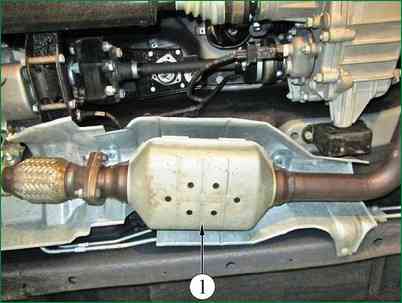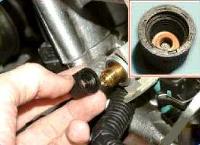To comply with Euro-5 standards for the content of harmful substances in exhaust gases, it is necessary to use a catalytic converter in the exhaust system
To comply with Euro-5 standards, an additional silencer 21230-1200018-50 with a converter 21230-1206026-50 is used.

The use of a catalytic converter gives a significant reduction in emissions of hydrocarbons, carbon monoxide and nitrogen oxides with exhaust gases, subject to precise control of the combustion process in the engine.
To speed up the process of converting hydrocarbons, carbon monoxide and nitrogen oxides into non-toxic compounds, the neutralizer has oxidizing and reducing catalysts.
Platinum is the oxidation catalyst. It contributes to the oxidation of hydrocarbons and carbon monoxide contained in the exhaust gases into water vapor and carbon dioxide.
The reduction catalyst is rhodium. It accelerates the chemical reaction of reducing nitrogen oxides into harmless nitrogen, which is one of the constituents of the air.
Oxygen is required to neutralize hydrocarbons and carbon monoxide. At the same time, nitrogen oxides are reduced.
Therefore, for the efficient operation of the converter, it is necessary to accurately maintain the balance of the air-fuel mixture supplied to the engine.
The increased residual oxygen content in the exhaust gases (during the combustion of lean mixtures) makes it difficult to restore nitrogen oxides.
The reduced oxygen content in the exhaust gases (during the combustion of rich mixtures) makes it difficult to oxidize carbon monoxide and hydrocarbons.
Only a precise balance of the air-fuel mixture ensures effective neutralization of all three toxic components.
The most complete combustion of the air-fuel mixture and the most effective neutralization of the aforementioned toxic components of exhaust gases are provided with an air-to-fuel ratio of 14.5-14.6: 1, i.e. 14.5-14.6 kg of air per 1 kg of fuel.
During the operation of a faulty engine, the catalytic converter may fail due to thermal stresses (above 970 ° C) to which it is subjected when excess hydrocarbons are oxidized.
In case of thermal stresses, the ceramic blocks of the catalytic converter can break down (block up), causing an increase in exhaust gas pressure.
A possible cause of catalytic converter failure is the use of leaded gasoline.
Tetraethyl lead contained in it in a short time leads to poisoning of the neutralizer, which significantly reduces its effectiveness.
Also, the reason for the failure of the converter is the use of gaskets containing silicone, and the use of non-recommended types of motor oils with a high content of sulfur and phosphorus.
Diagnosis of the state of the converter is carried out by the controller, which compares the signals of the oxygen sensors before and after the converter.
If a decrease in the efficiency of the converter is detected, which can cause the amount of harmful emissions to go beyond Euro-5 standards, the controller generates an appropriate fault code and turns on the alarm.










